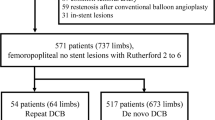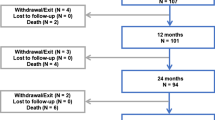Abstract
Objectives
The principal objective of this pooled analysis was to investigate various patient and lesion characteristics on late lumen loss (LLL) after drug-coated balloon (DCB) angioplasty.
Background
Four randomized controlled trials (THUNDER, FEMPAC, PACIFIER, CONSEQUENT) were pooled to investigate the influence of various patient and lesion characteristics on DCB angioplasty and on plain old balloon angioplasty (POBA) in patients with femoropopliteal artery disease.
Methods
Angiographic data from 355 patients were pooled to assess the impact of patient (demographics, cardiovascular risk factors, cardiovascular co-morbidities, Rutherford stages) and lesion-/procedure-related (location, occlusion, length, restenosis, calcification, subintimal crossing, post-dilatation, dissection, stenting) characteristics on LLL. Linear regression models were utilized with LLL as the dependent variable to determine the predictive value of cardiovascular and lesion-/procedure-related factors.
Results
Observational statistics revealed that LLL was lower in the DCB group as compared to POBA independent of all tested patient variables. LLL after DCB was also independent of most lesion and procedural characteristics except for lesion length and bailout stenting. LLL increased with lesion length in both treatment groups. Bailout stenting did not improve LLL in the DCB group but did so in the POBA group (0.74 ± 1.07 mm vs. 1.22 ± 1.36 mm, p = 0.043).
Conclusions
DCB was superior to POBA for all tested patient subgroups and lesion subgroups. Our results suggest that all patients and lesions benefit to a similar degree from the use of DCB. DCB-PTA should therefore be preferred to POBA in all patients with steno-occlusive femoropopliteal lesions.



Similar content being viewed by others
Change history
12 March 2019
In their recently published pooled analysis of four drug-coated balloon (DCB) studies, which focused on the impact of patient and lesion characteristics on LLL at 6 months (Albrecht T et al. Cardiovasc Intervent Radiol. 2018 Dec 11. <ExternalRef><RefSource>https://doi.org/10.1007/s00270-018-2137-3</RefSource><RefTarget Address="10.1007/s00270-018-2137-3" TargetType="DOI"/></ExternalRef>), the authors reported slightly inaccurate 2-year mortality rates.
References
Rosenfield K, Jaff MR, White CJ, LEVANT 2 Investigators, et al. Trial of a paclitaxel-coated balloon for femoropopliteal artery disease. N Engl J Med. 2015;373:145–53.
Laird JR, Schneider PA, Tepe G, IN.PACT SFA Trial Investigators, et al. Durability of treatment effect using a drug-coated balloon for femoropopliteal lesions: 24-month results of IN.PACT SFA. J Am Coll Cardiol. 2015;66:2329–38.
Schroeder H, Werner M, Meyer, ILLUMENATE EU RCT Investigators, et al. Low-dose paclitaxel-coated versus uncoated percutaneous transluminal balloon angioplasty for femoropopliteal peripheral artery disease: one-year results of the ILLUMENATE European randomized clinical trial (randomized trial of a novel paclitaxel-coated percutaneous angioplasty balloon). Circulation. 2017;135:2227–36.
Katsanos K, Spiliopoulos S, Paraskevopoulos I, et al. Systematic review and meta-analysis of randomized controlled trials of paclitaxel-coated balloon angioplasty in the femoropopliteal arteries: role of paclitaxel dose and bioavailability. J Endovasc Ther. 2016;23:356–70.
Giacoppo D, Cassese S, Harada Y, et al. Drug-coated balloon versus plain balloon angioplasty for the treatment of femoropopliteal artery disease: an updated systematic review and meta-analysis of randomized clinical trials. JACC Cardiovasc Interv. 2016;9:1731–42.
Tepe G, Zeller T, Albrecht T, et al. Local delivery of paclitaxel to inhibit restenosis during angioplasty of the leg. N Engl J Med. 2008;358:689–99.
Werk M, Langner S, Reinkensmeier B, et al. Inhibition of restenosis in femoropopliteal arteries: paclitaxel-coated versus uncoated balloon: femoral paclitaxel randomized pilot trial. Circulation. 2008;118:1358–65.
Werk M, Albrecht T, Meyer DR, et al. Paclitaxel-coated balloons reduce restenosis after femoro-popliteal angioplasty: evidence from the randomized PACIFIER trial. Circ Cardiovasc Interv. 2012;5:831–40.
Tepe G, Gögebakan Ö, Redlich R, et al. Angiographic and clinical outcomes after treatment of femoro-popliteal lesions with a novel paclitaxel-matrix coated balloon catheter. Cardiovasc Intervent Radiol. 2017;40:1535–44.
Pietzsch JB, Geisler BP, Garner AM, et al. Economic analysis of endovascular interventions for femoropopliteal arterial disease: a systematic review and budget impact model for the United States and Germany. Catheter Cardiovasc Interv. 2014;84:546–54.
Salisbury AC, Li H, Vilain KR, et al. Cost-effectiveness of endovascular femoropopliteal intervention using drug-coated balloons versus standard percutaneous transluminal angioplasty: results from the IN.PACT SFA II trial. JACC Cardiovasc Interv. 2016;9:2343–52.
Albrecht T, Waliszewski M, Roca C, et al. Two-Year clinical outcomes of the CONSEQUENT trial: Can femoropopliteal lesions be treated with sustainable clinical results that are economically sound? Cardiovasc Intervent Radiol. 2018;41:1008–14.
Tepe G, Zeller T, Schnorr B, et al. High-grade, non-flow-limiting dissections do not negatively impact long-term outcome after paclitaxel-coated balloon angioplasty: an additional analysis from the THUNDER study. J Endovasc Ther. 2013;20:792–800.
Jia X, Zhang J, Zhuang B, et al. Acotec drug-coated balloon catheter: randomized, multicenter, controlled clinical study in femoropopliteal arteries: evidence from the AcoArt I trial. JACC Cardiovasc Interv. 2016;9(18):1941–9.
Liistro F, Grotti S, Porto I, et al. Drug-eluting balloon in peripheral intervention for the superficial femoral artery: the DEBATE-SFA randomized trial (drug eluting balloon in peripheral intervention for the superficial femoral artery). JACC Cardiovasc Interv. 2013;6:1295–302.
Fanelli F, Cannavale A, Gazzetti M, et al. Calcium burden assessment and impact on drug-eluting balloons in peripheral arterial disease. Cardiovasc Intervent Radiol. 2014;37:898–907.
Tepe G, Beschorner U, Ruether C, et al. Drug-eluting balloon therapy for femoropopliteal occlusive disease: predictors of outcome with a special emphasis on calcium. J Endovasc Ther. 2015;22:727–33.
Acknowledgements
The authors wish to thank the research team at InnoRa Berlin, Germany (Dr. Bettina Kelsch, Dr. Beatrix Schnorr, and Dr. Ines Gemeinhardt), for their support during the course of previously conducted RCT’s with angiographic primary endpoints.
Author information
Authors and Affiliations
Corresponding author
Ethics declarations
Conflict of interest
In the previously conducted randomized controlled trials that provided the raw data for this analysis, TA, MW, TZ and GT received research grants from Medtronic, whereas TA, TZ and GT obtained research funding from B.Braun. MWW is a full-time employee of the Medical Scientific Affairs department of B.Braun Melsungen AG.
Ethical Approval
All studies were approved by the Federal Institute for Drugs and Medical Devices, by the Federal Agency for Radiation Protection and by all relevant ethics committees of participating centers. Patients gave written informed consent prior to inclusion. An independent critical event committee was installed to adjudicate event rates. Blinded quantitative angiographic analysis was conducted by an independent core lab. All trials were registered with the US National Institutes of Health prior to recruitment. This trial was conducted in accordance with the updated Declaration of Helsinki and other relevant guidance.
Informed Consent
Informed consent was obtained from all individual participants included in the study.
Rights and permissions
About this article
Cite this article
Albrecht, T., Ukrow, A., Werk, M. et al. Impact of Patient and Lesion Characteristics on Drug-Coated Balloon Angioplasty in the Femoropopliteal Artery: A Pooled Analysis of Four Randomized Controlled Multicenter Trials. Cardiovasc Intervent Radiol 42, 495–504 (2019). https://doi.org/10.1007/s00270-018-2137-3
Received:
Accepted:
Published:
Issue Date:
DOI: https://doi.org/10.1007/s00270-018-2137-3




